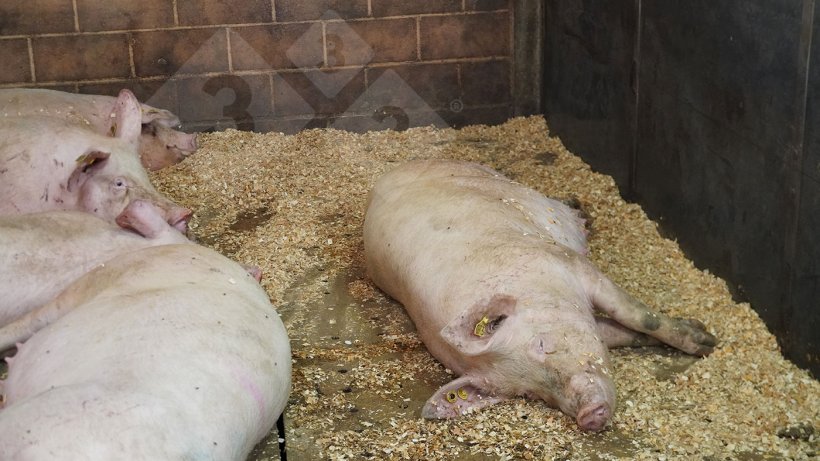Commented article
Palermo Mende, J., Ribeiro Caldara F., de Castro Burbarelli M.F., Kaique Valentim J., Ferreira de Brito Mandú D., Garófallo Garcia R., Correia de Lima Almeida-Paz I., Markiy Odakura, A. and M.I. Lourenço da Silva. Animals 2023, 13, 1226. https:// doi.org/10.3390/ani13071226
Read the summary of the article

Academic commentary by Josep Gasa
The objective of the research was to evaluate the effects of auditory environmental enrichment during the entire reproductive cycle (gestation and lactation) of sows housed in stalls until day 35 of gestation or released 72 hours post-insemination. Reproductive performance and eye temperature (ET) were evaluated as an indicator of sow welfare. Fifty-six second to sixth parity sows were distributed in a randomized block design with a 2x2 factorial design:
- Housing:
- group housed after day 35
- breed and release
- Without music and with music
Auditory enrichment consisted of exposing the sows daily during gestation and lactation to six hours of classical music divided into three two-hour periods. Bach music was chosen at an intensity of 60 to 75 dB.
The eye temperature of gestating sows that were group-housed 72 hours post-insemination was lower than that of sows housed in stalls until day 35 (33.77ºC vs. 34.91ºC).
Gestating and lactating sows exposed to auditory environmental enrichment exhibited lower eye temperatures than unstimulated sows (gestating 33.36ºC vs. 34.32ºC and lactating 34.21ºC vs. 34.83ºC).
Housing type did not affect productive performance; however, piglets from sows subjected to auditory environmental enrichment, regardless of the type of housing used in gestation, were significantly heavier at weaning (6.32 kg vs. 5.57 kg).
Exposing gestating and lactating sows to classical music reduced their eye temperature, suggesting a reduction in the stress inherent in these production phases, and this stress reduction resulted in higher piglet weaning weights.

Photo 1. Sows resting.
It is known that auditory environmental enrichment can relieve stress in animals and has positive behavioral effects in pigs and other species. Classical music compared to other music seems to promote greater relaxation and reduce agonistic behaviors and stereotypies. However, there is hardly any information referring to sows that also relates the effects of environmental auditory enrichment, not only with the state of well-being but also with productive parameters.
The experiment is well designed and the results are correctly processed and interpreted. The authors point out that the positive effects of music on piglet weaning weights may be related to sow and piglet welfare. Lactating sows with better welfare conditions show less stereotypies and are assumed to increase attention to the litter by increasing nursing frequency. On the other hand, piglets exposed to music tend to have less agonistic behaviors and more play behaviors.
It is noteworthy that of the multiple productive parameters recorded during gestation and lactation, only the piglet weight at weaning was significant, with an improvement of 750 g at weaning for piglets from the treatment with music, together with a trend in the weaning to estrus interval (p=0.077) favoring the treatment without music. The experiment was conducted in Mato Grosso, Brazil; a tropical climate with dry winters, annual rainfall between 1,200 and 1,800 mm, and extreme temperatures between 10 and 40ºC.
On-farm commentary by Josep Casanovas
This trial is very interesting to me. It opens a door that we should all try to keep open.
We should try to implement everything that can be done to improve true animal welfare; especially when the cost of implementation is not necessarily exorbitant, as in the present case.
A good part of our job is ensuring animal welfare, so it is important to understand the different details to achieve it as fully as possible.

One of the most significant problems we encounter when discussing welfare is defining it, knowing what it really is. Most people find it difficult to grasp what well-being is for them. There are no parameters that offer absolute well-being for everyone. For people who work, well-being means having a few days off; for those who are unemployed and looking for work, well-being means having a job.
It is clear that good housing, good feeding, and good health are the basic, minimum, elementary limitations to offer animal welfare. In these three aspects, the needs are clear and have been perfectly described for many years.
The situation is complicated bhe fourth element, which refers to the need to express behavior and relationships with other animals, including humans, in order to achieve good welfare conditions.
As in so many other things with welfare, the law of 20/80 is followed. By correctly meeting 20% of the needs, 80% of the welfare is achieved, but to achieve the other 20%, 80% of the needs must be met.
The challenge, if we want to improve welfare conditions beyond the most elementary, is to identify, know, and apply all those details, in this case offering auditory environmental enrichment, which can achieve maximum benefit in terms of welfare.
This is not easy. If it is difficult to define our own well-being, how can we dare to define what well-being for an animal is.
The ISDE (International Six Days Enduro) was recently held in Silleda, Spain. In the picture, we can see a herd of cows perfectly naturally enjoying a special section.

Photo 2. International Six Days Enduro in Silleda.
I say "enjoying" because despite the rain, fog, and mud I enjoyed it. But did the cows really enjoy it or did they suffer for six days, who knows?
It is very important to provide evidence that can objectively demonstrate real welfare situations. Mammals have five senses, and all of them can provide us with sensations of well-being. It is important to explore the different sources of well-being through the different senses.
In view of the results of the study, I have some questions:
- Did the music affect only the animals, and were the staff caring for the animals also affected by the music? Implementing measures to improve the welfare situation for both the animals and their caretakers is a challenge.
- I do not know exactly why the researchers decided to schedule the exposure to music in three two-hour periods each day. If the presence of music is an auditory environmental enrichment that improves welfare conditions, can we think that the absence of this enriching stimulus will cause them to fall into a situation of discomfort? If this is so, the most affected group will be only the one that knows about the existence of music.
That said, the researchers have opened a door that would be very interesting not to close.
Summary of the commented articlePalermo Mende, J., Ribeiro Caldara F., de Castro Burbarelli M.F., Kaique Valentim J., Ferreira de Brito Mandú D., Garófallo Garcia R., Correia de Lima Almeida-Paz I., Markiy Odakura, A. and M.I. Lourenço da Silva. Animals 2023, 13, 1226. https:// doi.org/10.3390/ani13071226 Methods: The research aimed to assess the effects of auditory environmental enrichment on sows in mixed housing (caged until 35 days after insemination and then collective pens) or collective housing (caged until 72 hours after insemination and then collective pens). Reproductive performance, body surface, and eye temperature were evaluated as sows’ welfare indicators. A sample of 56 sows between their second and sixth parity was submitted to the treatments from artificial insemination to weaning. The sows were assigned in a randomized block design with a 2x2 factorial scheme of treatments: mixed housing—control, collective housing—control, mixed housing—music, and collective housing—music. Auditory enrichment consisted of exposing sows daily throughout gestation and lactation to six hours of classical music divided into two-hour periods. Results: The eye temperature of pregnant sows in collective housing was lower than that of sows in mixed housing (33.77 ºC vs. 34.91 ºC). Pregnant and lactating sows exposed to auditory environmental enrichment exhibited lower eye temperature compared to those that had no access to the stimulus (pregnant 33.36 ºC vs. 34.32 ºC and lactating 34.21 ºC vs. 34.83 ºC). No housing type effect was found on the reproductive performance parameter; however, piglets from sows submitted to auditory environmental enrichment, regardless of the type of housing during gestation, were heavier at weaning (6.32 kg vs. 5.57 kg). Collective or mixed housing does not affect sows’ reproductive performance; perhaps, auditory environmental enrichment reduced stress in the gestation and lactation phases and provided greater piglet weight gain at weaning. Conclusion: Exposing pregnant and lactating sows to classical music reduced their eye temperature, which suggests a decrease in stress inherent to these productive phases. Stress reduction resulted in higher piglet weight at weaning. |








